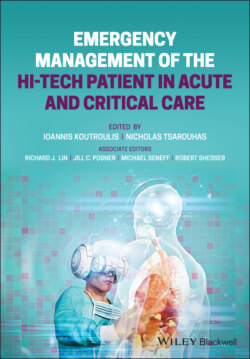Читать книгу Emergency Management of the Hi-Tech Patient in Acute and Critical Care - Группа авторов - Страница 15
Equipment/Device
ОглавлениеEnteral feeding devices can be categorized into temporary and long‐term devices. Furthermore, the name for each device comes from its origin (nose, mouth, or stomach) and terminus (stomach or small intestine) (Table 1.1). Nasal and oral tubes are temporary and work well for patients with transient feeding difficulties. Gastrostomy tubes (G‐tube) and jejunostomy tubes (J‐tube) are ideal for more long‐term or permanent enteral nutrition. Enteral feeding devices are sized in French (Fr) units, which is the outer diameter of the tube in millimeters multiplied by three. A 9 Fr tube, for example, has an outer diameter of 3 mm. Tube lengths are usually given in centimeters and vary widely from very short low profile “button” type tubes to very long naso‐jejunal (NJ) tubes.
Table 1.1 Enteric feeding devices.
| Origin | Destination | Tube | Abbreviated | Placement |
| Temporary feeding devices | ||||
| Nose (naso‐) | Stomach (gastric) Duodenum Jejunum | Naso‐gastric Naso‐duodenal Naso‐jejunal | NG ND NJ | Bedside |
| Mouth (oro‐) | Oro‐gastric | OG | Bedside | |
| Long‐term feeding devices | ||||
| Percutaneous | Stomach Jejunum | Gastrica Gastro‐jejunostomy Jejunostomy | G‐tube GJ J‐tube | Surgically or endoscopically Fluoroscopically Fluoroscopically |
a Commonly, these tubes are called “PEG tubes”; however, a percutaneous endoscopic gastrostomy is a procedure and not a specific tube.
